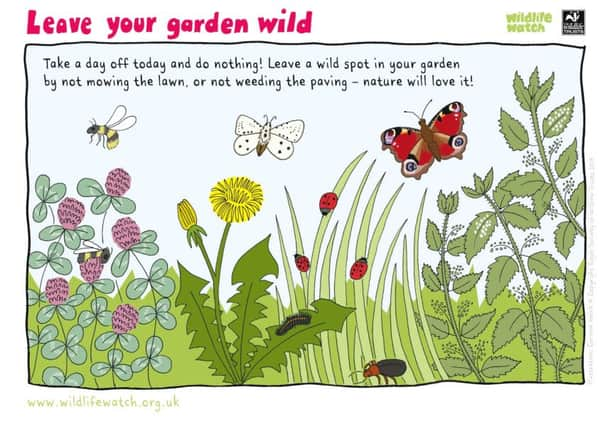Be less tidy and help garden wildlife


If you want to encourage wildlife into your garden, one of the best and easiest things you can do is be less tidy...permission to relax!
Let your grass grow
If you have a lawn, it can be home to an astonishing number of creatures, especially if you let a patch of it grow longer in spring. This will provide you with an instant mini-meadow and will provide a home for all sorts of insects such as butterflies, moths and grasshoppers. Even simply raising the height of your mower blade by a few inches and mowing less frequently can make a massive difference.
Leave dandelion and
nettle patches
Advertisement
Hide AdAdvertisement
Hide AdLetting some ‘weeds’ grow such as nettles (even in just one shady corner) provides vital food for the caterpillars of many butterflies such as red admiral and tortoiseshell, whilst a patch of dandelions and clover provides welcome nectar for early bumblebees.
Pile up logs
A pile of logs in a shady corner of the garden offers a vital refuge for many mini-beasts such as beetles and spiders, as well as creatures such frogs, newts, hedgehogs and mice. Birds such as thrushes and blackbirds will also be attracted by the food on offer. Wood from broad-leaved trees such as oak and ash attract the greatest range of species; treated wood should be avoided.
Cut back on cutting back
Make sure you leave plenty of tree and hedge cover for birds to shelter and feed in especially during bird nesting season, between March and August. Cutting your hedges during this time could actually be an offence as it is illegal to disturb bird’s nests and their young.
Plant wild flowers
Native flowers are hugely important for wildlife as they flower at the right time of year for our insects.
Advertisement
Hide AdAdvertisement
Hide AdYou don’t need a huge amount of space – consider turning an unused front lawn or corner of your garden into a meadow, or plant up a wildflower container or window box if space is limited.
Create a compost heap
Besides being one of the best ways to enrich your soil and reduce waste going to landfill, compost heaps are miniature nature reserves in themselves - providing a feast for woodlice and worms, and in turn a brilliant place for frogs and hedgehogs.
If you would like more wildlife gardening tips then visit the website at ulsterwildlife.org/wildlife-gardening